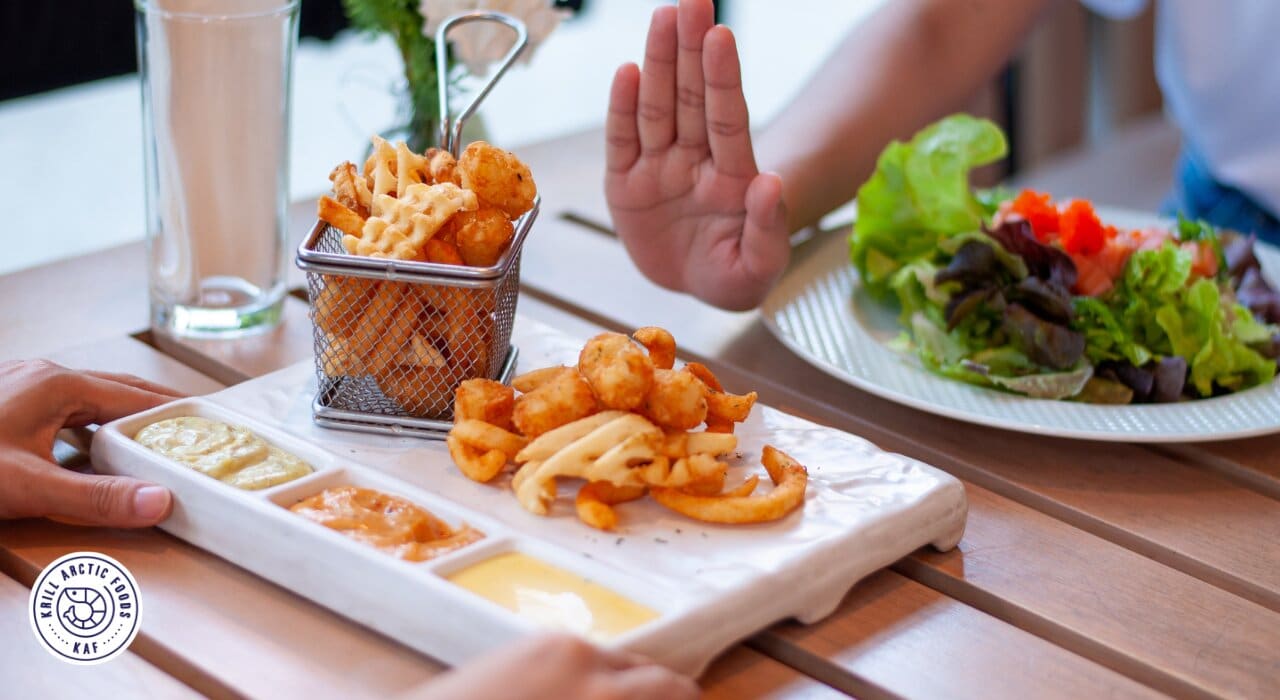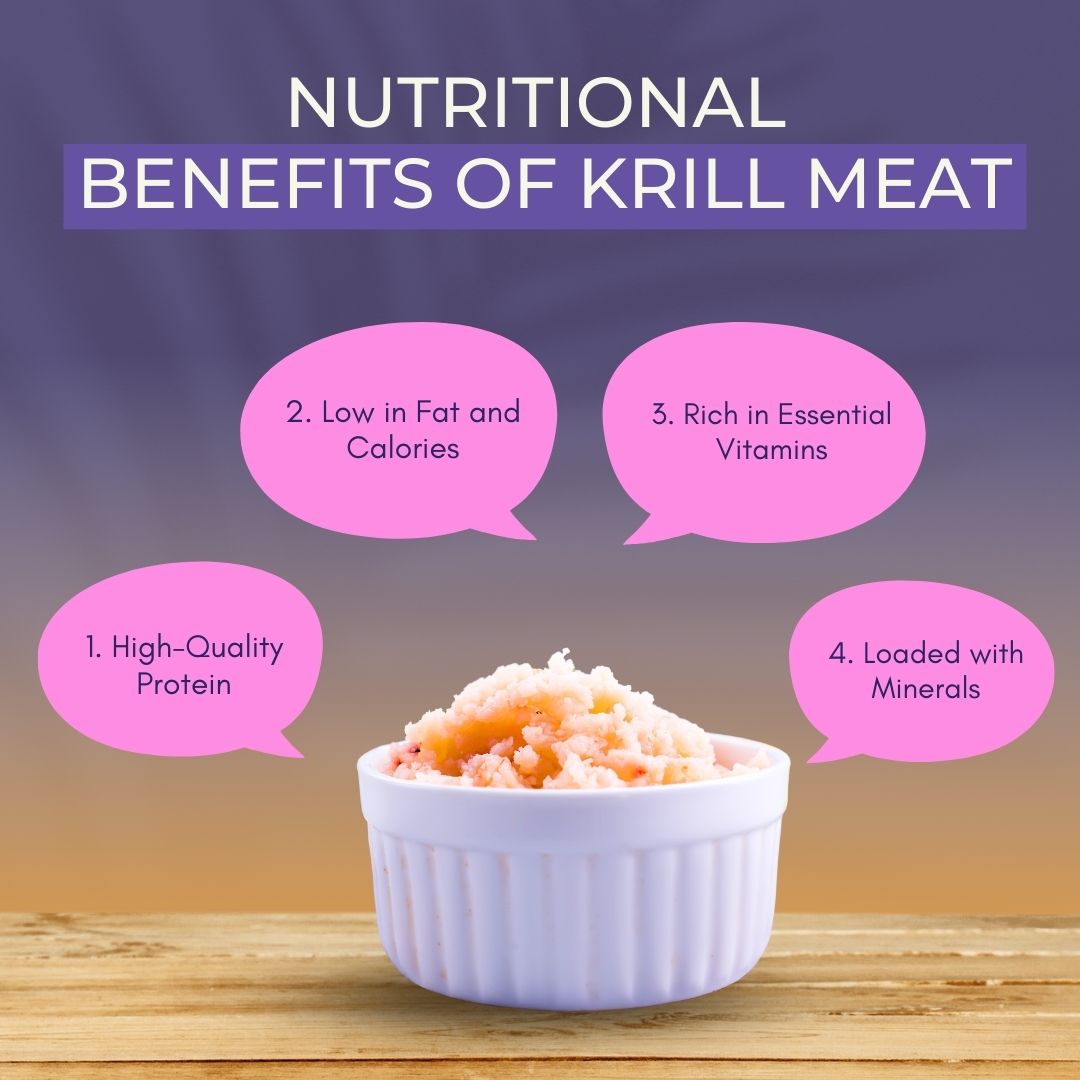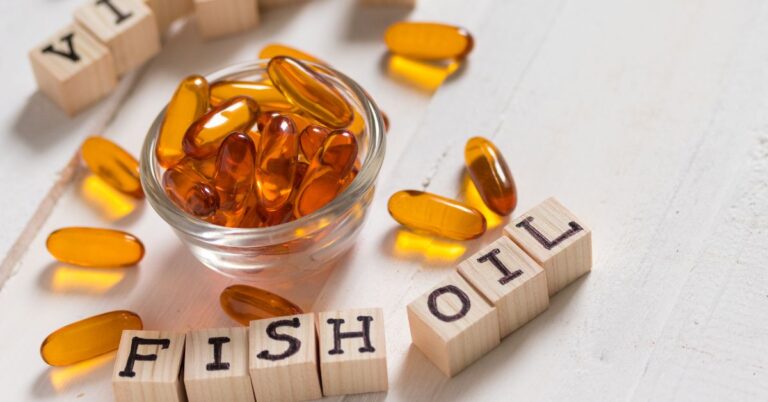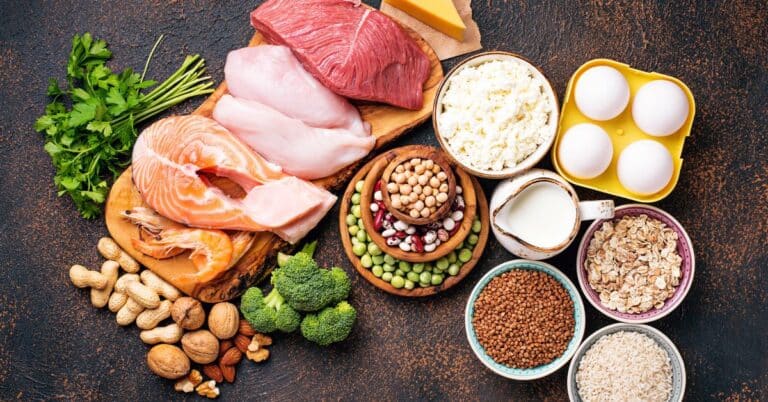Starting Ozempic can feel like the breakthrough you’ve been waiting for there’s excitement mixed with a bit of hesitation. What foods to avoid while on ozempic? Whether it’s your first time on a weight loss medication or you’re using it to better manage type 2 diabetes after trying other treatments, you’re hoping for lasting change.
However, with that promise of transformation often comes a wave of side effects: nausea, bloating, fatigue, constipation, or loss of appetite.
What many people don’t realize is that these symptoms may not be entirely due to the medication itself but rather how your body is reacting to the food you’re eating.
Ozempic doesn’t just affect your weight or blood sugar it changes how your body processes food. If your diet isn’t aligned with these changes, you could end up feeling worse instead of better.
The good news is that most of Ozempic’s side effects can be minimized simply by adjusting your eating habits. In this guide, you’ll learn what to avoid eating while on Ozempic, how certain foods can ease or worsen side effects, and how understanding these changes can help you feel more in control of your experience.
How Ozempic Works: What foods to avoid while on ozempic
To understand why diet matters on Ozempic, you first need to understand what it’s doing behind the scenes.
Ozempic (semaglutide) is part of a class of medications called GLP-1 receptor agonists. It simply means this medication tells your brain and body to slow down. It tells your stomach, “Take your time.” It tells your brain, “We’re full now.” And it tells your pancreas, “Let’s keep that blood sugar nice and steady.” These changes are incredibly helpful when you’re trying to lose weight or manage diabetes. But it also means-
- Slowing down gastric emptying, meaning food stays in your stomach longer. which can lead to nausea or constipation if you’re not eating the right foods.
- Suppressing appetite helps you feel full sooner and eat less, which sounds like a win until you accidentally skip meals and end up dizzy or drained.
- Regulating your blood sugar, especially after meals, means sugary or carb-heavy foods can cause big crashes and even bigger cravings.
If you continue to eat the way you did before Ozempic, you may unintentionally worsen side effects like: Persistent nausea, Bloating or fullness after small meals. Fatigue and low energy or irregular bowel movements.
Foods to Avoid While on Ozempic

Now that you understand why your digestion changes on Ozempic, here’s a breakdown of the foods most likely to cause issues plus simple swaps to keep you feeling good.
Fried and Greasy Foods
Heavy, fatty meals are harder to digest, especially when your stomach is already emptying slowly because of Ozempic. This can overwhelm digestion, heartburn, or stomach pain.
Some examples include fried chicken, French fries, onion rings, bacon-heavy breakfasts, creamy pasta sauces, and buttery dishes.
Sugary and Refined Carbohydrates
These spike your blood sugar quickly, then crash it leaving you tired, moody, and craving more sugar.
Some examples are pastries, cookies, candy, white bread, sweetened cereals, and sugary drinks like soda.
Highly Processed Packaged Foods
Packaged foods are often loaded with hidden sugars, unhealthy fats, and preservatives that can throw digestion and energy off.
Some examples include chips, frozen dinners, deli meats high in preservatives, flavored snack bars, and “low-fat” items with added sugars..
Caffeinated Beverages
Caffeine can irritate your stomach lining and overstimulate your system, especially if you’re drinking it on an empty stomach.
Some examples include black coffee, energy drinks, espresso shots, and highly caffeinated teas.
High-Sodium Foods
Sodium can cause bloating and water retention and can interfere with your hydration something that’s especially important on Ozempic.
Some examples are canned soups, instant noodles, processed meats, fast food, and salty snacks.
Starchy Vegetables (in excess)
Starchy veggies behave more like carbs than fiber, which can raise blood sugar fast if eaten in large amounts without protein or healthy fats.
Some examples include potatoes, corn, green peas, butternut squash, and parsnips.
Carbonated Drinks
Fizzy beverages can trap air in your digestive system, making bloating and gas worse when your stomach is already slower to empty.
Some examples are soda, sparkling water, tonic water, beer, and fizzy kombucha.
Alcohol
Alcohol can irritate your stomach, destabilize blood sugar and intensify fatigue or dizziness.
Some examples include beer, wine, hard liquor, and sugary cocktails.
Large Portions and Overeating
Eating large meals while on Ozempic can cause prolonged fullness, nausea, or even vomiting due to slower digestion.
This includes oversized restaurant portions, buffet-style meals, or eating until you feel stuffed.
Artificial Sweeteners
Some sugar substitutes, especially sugar alcohols, can irritate the gut.
Some examples of artificial sweeteners are sorbitol, xylitol, sucralose, aspartame, “sugar-free” gums, mints, and protein bars.
Try instead stevia or monk fruit in small amounts or unsweetened snacks with natural ingredients.
Spicy Foods
While some people can tolerate spicy meals just fine, others may find that spicy ingredients irritate their stomach lining. This can trigger acid reflux or stomach cramps.
Some examples include hot sauces, chili peppers, jalapeños, curry-heavy dishes, and meals loaded with cayenne or red pepper flakes..
High-Fat Dairy
Full-fat dairy products can slow down digestion even more for some people especially those with lactose sensitivity, which is more common than most realize.
Some examples include whole milk, heavy cream, full-fat cheese, ice cream, and creamy dressings.
Fruit Juices & Smoothies
Even though they seem healthy, fruit juices and store-bought smoothies are often packed with sugar and stripped of fiber leading to high blood sugar spikes and crashes.
Some examples include orange juice, apple juice, bottled smoothies, and “detox” juices.
Healthy Swaps for Ozempic Users: Easy Alternatives to Keep You Feeling Good
If you’re experiencing side effects from Ozempic, your food choices might be contributing to those discomforts. Here are some simple swaps you can make to support your body and minimize unwanted symptoms.
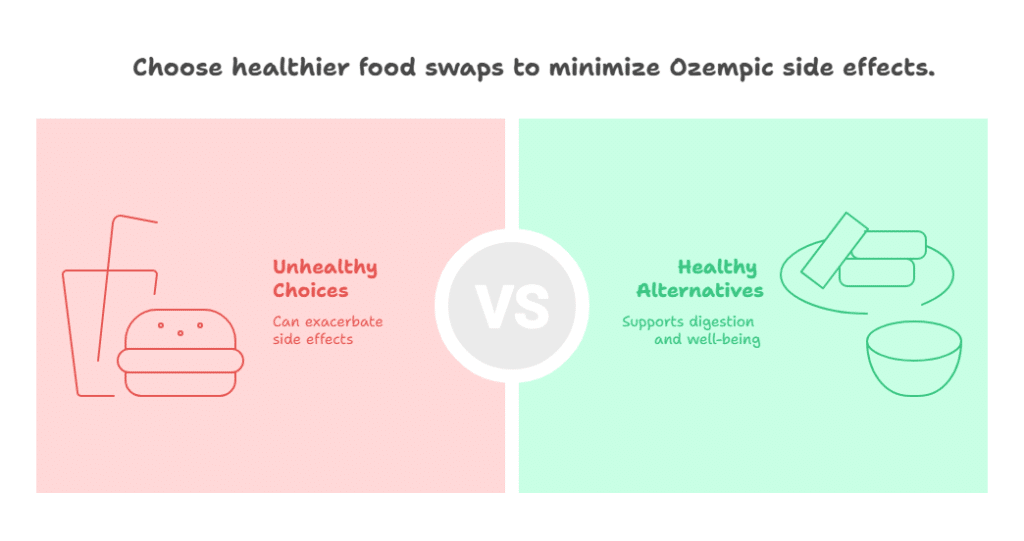
Swap Fried & Greasy Foods for: Grilled, Baked, or Steamed Meals
Opt for grilled chicken, roasted vegetables, or baked fish instead of fried dishes like chicken nuggets or French fries. This reduces the heaviness and oil, making digestion easier.
Swap Sugary & Refined Carbs for: Whole Grains and Natural Sweeteners
Instead of pastries and white bread, try whole-grain options like quinoa, brown rice, or oatmeal. For a sweet fix, choose fresh fruit or natural sweeteners like stevia or monk fruit.
Swap Highly Processed Packaged Foods for: Whole, Fresh Foods
Skip packaged snacks like chips and opt for fresh fruit, veggies, or homemade energy bars made from oats and nuts. When choosing pre-made meals, check labels for whole, natural ingredients with minimal preservatives.
Swap Caffeinated Beverages for: Herbal Teas or Decaf Alternatives
Try chamomile, peppermint, or ginger tea instead of black coffee or energy drinks. These teas can soothe your stomach and promote digestion without overstimulating your system.
Swap High-Sodium Foods for: Low-Sodium Homemade Options
Instead of canned soups or processed deli meats, make your own soups with low-sodium broth, and use fresh herbs for flavor. Opt for unsalted snacks like nuts or veggie sticks to keep sodium intake low.
Swap Starchy Vegetables (in excess) for: Non-Starchy Vegetables
Instead of potatoes, corn, or peas, go for cauliflower, broccoli, or leafy greens like spinach and kale. These are lower in carbs and fiber-rich, making them easier to digest and less likely to spike blood sugar.
Swap Carbonated Drinks for: Still Water or Infused Water
Choose still water or sparkling water with fresh fruit slices like lemon or cucumber for a refreshing, fizzy alternative without the bloat. Herbal teas or iced teas can also be a good swap to keep you hydrated.
Swap Alcohol for: Mocktails or Non-Alcoholic Drinks
Instead of beer or sugary cocktails, try mocktails made with soda water and fresh fruit, or go for non-alcoholic beer or wine. These alternatives provide the social experience without irritating your stomach or destabilizing blood sugar.
Swap Large Portions for: Smaller, Balanced Meals
Rather than overeating, aim for smaller meals spread throughout the day. A balanced meal of lean protein, healthy fats, and fiber (like a salad with grilled chicken and avocado) will keep you full without overwhelming your digestive system.
Swap Artificial Sweeteners for: Natural Sweeteners or Whole Foods
Instead of sugar alcohols or artificial sweeteners, opt for stevia, monk fruit, or naturally sweet foods like berries or a small piece of dark chocolate. This will reduce digestive irritation and keep your blood sugar levels steady.
Swap Spicy Foods for: Mildly Seasoned Dishes
Choose herbs like basil, oregano, or rosemary instead of spicy peppers or hot sauces. These will still add flavor but are less likely to irritate your stomach.
Swap High-Fat Dairy for:Low-Fat or Plant-Based Dairy
If full-fat dairy makes you feel sluggish, try low-fat or lactose-free options. Plant-based alternatives like almond milk, coconut yogurt, or soy cheese are also great choices for maintaining energy while avoiding digestive discomfort.
Whole Fruits or Homemade Smoothies
Instead of sugary fruit juices or store-bought smoothies, choose whole fruits or make your own smoothies using unsweetened almond milk, leafy greens, and berries. This way, you’ll get all the fiber and none of the added sugar.
Making these simple swaps can help prevent or reduce side effects and improve your overall experience on Ozempic. Focus on fresh, whole foods, and opt for meals that are easier on your digestion. With these changes, you’ll feel more in control and see positive effects on your health and well-being.
Listen to Your Body
No two people respond to Ozempic in the exact same way. Some might feel nauseous after just a bite of pizza, while others can tolerate occasional indulgences with no problem.
The key is to stay curious and tune into your body’s signals.
If something leaves you feeling sluggish, bloated, or irritable afterward, it’s worth adjusting. If something makes you feel energized, balanced, and satisfied add more of it.
Keeping a food and symptom journal for a few weeks can help you discover your personal “yes” and “no” foods.
The Ozempic Diet: What to Prioritize
Now you know what foods not to have while on Ozempic. Let’s talk briefly about what a supportive Ozempic diet looks like. Here’s what your body needs while on this medication:
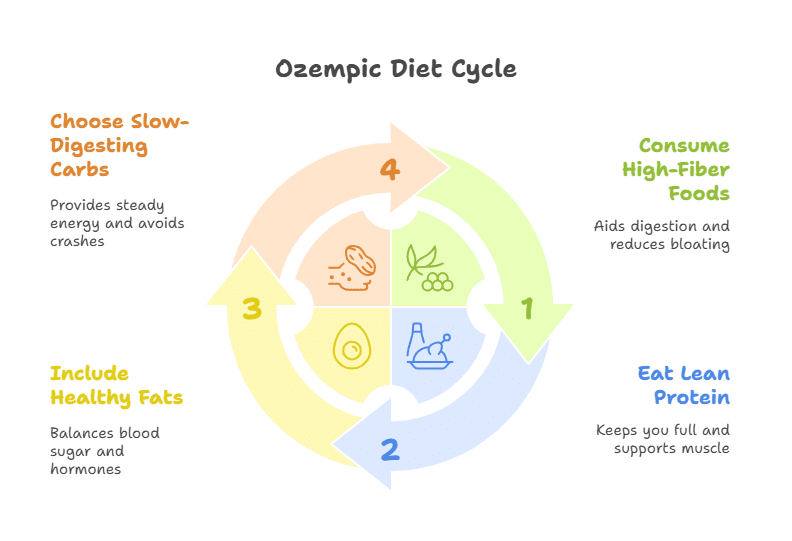
- High-fiber foods – These help keep digestion moving and reduce bloating. Think leafy greens, berries, chia seeds, and roasted veggies. A fiber-rich breakfast like oatmeal with flaxseed can also go a long way.
- Lean protein – Protein keeps you full longer, protects your muscle as you lose fat, and helps your body recover from exercise. Go for easy-to-digest options like krill meat (packed with clean protein and omega-3s), skinless chicken breast, eggs, Greek yogurt, or tofu.
- Healthy fats – The right fats help balance blood sugar and support hormone health. Avocados, olive oil, fatty fish like salmon, and a handful of almonds are great options. They also help keep cravings down between meals.
- Slow-digesting carbs – These give you steady energy and help you avoid that mid-day crash. Choose foods like sweet potatoes, quinoa, steel-cut oats, and lentils. They fuel your workouts without spiking blood sugar.
This means focusing on whole, nutrient-dense meals fruits, vegetables, quality protein, and good fats while avoiding processed, sugary, or greasy foods that can make Ozempic side effects worse.
Final Thoughts: Eat Smarter, Feel Better
Ozempic works best when you work with it not against it. Avoiding certain foods can make a huge difference in how you feel and how well the medication supports your goals.
Think of this less like a restrictive diet and more like a reset. You’re learning what makes you feel good, what triggers discomfort, and how to fuel your body for success.
Remember, your body is adjusting and it needs your support. Small shifts in your diet can lead to big improvements in how you feel day to day. Choose whole, nourishing foods. Avoid trigger foods when you can. And most importantly, listen to what your body is telling you.

